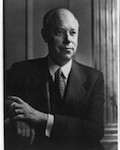In early 1939, in response to the Kristallnacht pogrom, U.S. Senator Robert Wagner (D-New York) and Rep. Edith Rogers (R-Massachusetts) introduced legislation to admit 20,000 German–presumably Jewish–children to the United States, outside America’s strict immigration quotas.
The Wagner-Rogers bill was supported by a wide range of clergymen, labor leaders, university presidents, actors such as Henry Fonda and Helen Hayes, and political figures such as 1936 Republican presidential nominee Alf Landon and his running mate, Frank Knox. Former First Lady Grace Coolidge announced she and her friends in Northampton, Massachusetts would personally care for 25 of the children.
The most prominent, and unexpected, political figure to back Wagner-Rogers was former president Herbert Hoover. Back in 1930, before Hitler, Hoover’s administration had tightened the restrictions on immigration. Hoover’s endorsement of a bill allowing greater immigration surprised political observers, made the front page of the New York Times, and was read aloud at the hearings on the bill. Hoover also assisted the sponsors of the bill behind the scenes, by pressuring wavering members of the House Immigration Committee to support the measure.
Numerous patriotic and anti-foreigner groups, including the American Legion and the Daughters of the American Revolution, mobilized against Wagner-Rogers. Laura Delano Houghteling, a cousin of President Franklin Roosevelt and wife of the U.S. Commissioner of Immigration, summarized the sentiment of the opposition when she complained that “20,000 charming children would all too soon grow up into 20,000 ugly adults.”
First Lady Eleanor Roosevelt privately supported the legislation, but said nothing about it in public. FDR himself took no position on Wagner-Rogers. An inquiry by a congresswoman as to the president’s stance was returned to Roosevelt’s secretary marked “File No action FDR.” Roosevelt was mindful of polls showing most Americans opposed to more immigration, and so he chose to–as Winston Churchill once described one of FDR’s traits–“follow public opinion rather than to form it and lead it.”
In April 1939, a joint Senate-House committee held four days of hearings on Wagner-Rogers. Sympathetic witnesses offered moving humanitarian pleas. They also stressed that children would not compete with American citizens for jobs. Nativist opponents presented standard anti-immigration claims as well as innovative assertions such as the claim that the wording of the bill could enable 20,000 Nazi children to come to the U.S. Therefore, they claimed, the effect of the bill would be to tear German families apart. The Senate and House subcommittees both voted unanimously in favor of Wagner-Rogers.
The legislation moved on to the full House Immigration Committee for its consideration. Opponents mounted a vigorous behind-the-scenes attack. This, together with the absence of White House support, resulted in a Committee vote that required the 20,000 child immigrants to be charged against the existing German quota. This maneuver nullified the entire original purpose of the legislation. Wagner-Rogers was, in effect, killed.
Ironically, a year later, when British children were endangered by German bombing raids, President Roosevelt and Congress joined hands to rush through legislation enabling thousands of those children to receive temporary haven in the United States.
Sources: Wyman, Paper Walls, pp.75-98; Feingold, The Politics of Rescue, pp.149-153.











